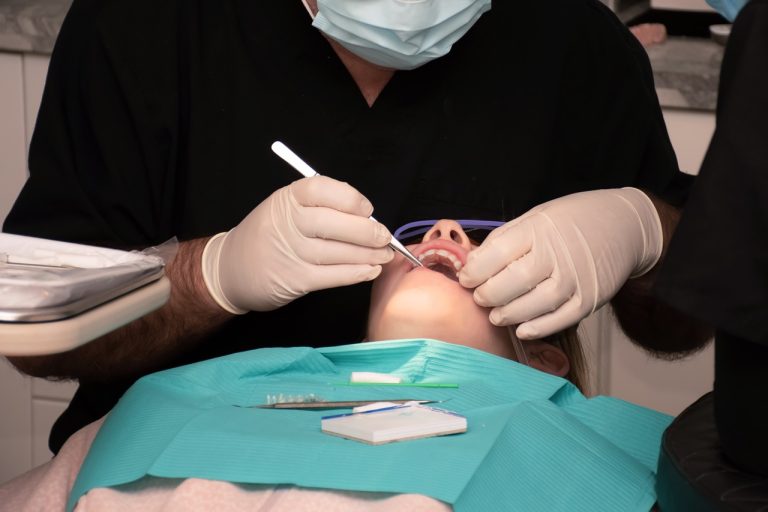Visiting the dentist for gum treatment might seem daunting, but understanding what happens during the visit can ease our worries. Gum health is just as important as keeping our teeth clean. Healthy gums support our teeth and help prevent pain, infection, and tooth loss. Knowing what to expect during a gum treatment visit can help us feel more comfortable and prepared.
Initial Examination and Assessment
The dentist carefully examines our gums when we first arrive for gum treatment. They look for signs of gum disease, such as redness, swelling, or bleeding. The dentist also checks the health of the tissues and measures the pockets around our teeth using a small ruler. This helps them understand if gum disease has caused deep spaces where bacteria might hide.
The dentist might take X-rays to see if the bone beneath the gums is healthy. These images show if there is any bone loss or other issues that need attention. The dentist asks about our oral hygiene routine, including how often we brush and floss and if we’ve noticed problems like bad breath or bleeding gums.
Based on this examination, the dentist will identify any problem areas and discuss the findings. They explain what they see and what it means for our gum health. This initial assessment helps create a treatment plan tailored to our needs, ensuring we get the best care possible.
Deep Cleaning Procedures
After the assessment, the next step is often a deep cleaning procedure called scaling and root planing. This process is crucial for removing plaque and tartar that regular brushing and flossing miss. Plaque is a sticky film of bacteria, and when it hardens into tartar, it can only be removed by a dentist.
Scaling involves using special tools to scrape away plaque and tartar from above and below the gum line. The dentist carefully cleans each tooth, reaching deep into the pockets around the gums. This helps eliminate bacteria and smooth the tooth surface, making it harder for plaque to stick in the future.
Root planing goes further by smoothing the roots of the teeth. This step helps the gums reattach to the teeth and prevents bacteria from finding new places to hide. The dentist might use a vibrating ultrasonic tool to break up the tartar or hand instruments for more precise cleaning.
These deep cleaning procedures are essential for stopping the progression of gum disease and promoting healthy gums. They clean the teeth thoroughly and set the stage for better oral health improvements.
Treatment for Gum Disease
If the initial examination reveals signs of gum disease, the dentist discusses appropriate treatments with us. One standard treatment is scaling and root planing, which we’ve already covered. However, more advanced cases of gum disease might require additional procedures.
The dentist might recommend antibiotic therapy to kill the remaining bacteria in our gums. These antibiotics can be applied directly to the gum pockets or taken orally. They help reduce bacteria and inflammation, promote healing, and prevent further infection.
In severe cases, we might need surgical treatments. One option is flap surgery, where the gums are lifted to remove tartar deep below the gum line. After cleaning, the gums are stitched back to fit snugly around the teeth. If we lose bone or gum tissue, bone and tissue grafts might be another option. These grafts help regenerate lost areas and provide a firm foundation for our teeth.
The dentist explains each procedure clearly, detailing what we expect during and after treatment. They also address any questions or concerns, ensuring we feel comfortable with our care plan. Receiving the proper treatment for gum disease is crucial for restoring our gum health and safeguarding our overall oral health.
Post-Treatment Care and Follow-Up
After our gum treatment, it is essential to care for our gums at home to ensure they heal properly and stay healthy. The dentist provides specific instructions on how to care for our gums after treatment. This might include using prescribed mouthwashes or medications to reduce swelling and prevent infection.
They also demonstrate proper brushing and flossing techniques to keep our gums clean. We may be advised to use a softer toothbrush and gentle brush to avoid irritating the treated areas. Flossing carefully around the gum line helps remove food particles and plaque that could cause further issues.
Regular follow-up visits are essential for monitoring our progress and ensuring the treatment works. During these visits, the dentist checks the health of our gums, looking for signs of improvement or any further issues. They might perform additional cleanings or adjustments to our treatment plan as needed.
We also receive tips on maintaining a healthy diet, as certain foods can impact our gum health. Avoiding sugary snacks and drinks and eating more fresh fruits and vegetables supports our oral health. Post-treatment care and regular check-ups help keep our gums healthy and prevent future problems.
Conclusion
Taking care of our gums through regular dental visits and treatments is essential for maintaining overall oral health. Understanding what happens during a gum treatment visit can help us feel more at ease and prepared for the procedures. From the initial examination and deep cleaning to specific treatments for gum disease and post-treatment care, each step is carried out to support our gum health.
Following the dentist’s recommendations and maintaining good oral hygiene practices at home are vital to ensuring the success of the treatment. Regular check-ups and professional cleanings are essential for promptly catching and addressing any issues.
At Colorado Gum Care Northglenn, CO, our dedicated team is here to provide comprehensive gum care tailored to your needs. Schedule your appointment today and take the first step towards healthier gums and a brighter smile. Contact our oral surgeons in Colorado, and let us help you achieve optimal gum health!







